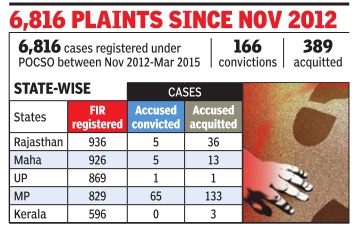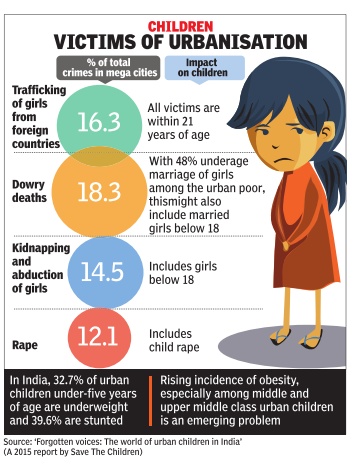Child abuse: India
This is a collection of articles archived for the excellence of their content. |
Protection of Children against Sexual Offences Act (POCSO)
The Times of India, Jul 09 2015

Himanshi Dhawan
8 cases of child abuse every day 6,816
Eight cases of sex crimes against children have been registered every day in the last two years. About 6,816 police cases were registered from November, 2012 -when the Protection of Children against Sexual Offences Act (POCSO)--came into force up to March, 2015. The highest number of FIRs has been registered in Rajasthan followed by Maharashtra, Uttar Pradesh, Madhya Pradesh and Kerala according to data available with the National Commission for Protection of Child Rights (NCPCR).The number of convictions is only 166 that is 2.4% of the total cases registered while in 389 cases accused were acquitted.
There is a rising trend of crime against children. This is also borne out by National Crime Records Bureau (NCRB) data that has recorded 33,052 Cases, 38,172 cases and 58,224 cases during 2011, 2012 and 2013 respectively . According to a study conducted by the WCD ministry in 2007, over half of the children surveyed reported having faced some form of sexual abuse, with their suffering exacerbated by the lack of specific legislation to provide remedies for these crimes.
While rape is considered a serious offence under the Indian Penal Code, the law was deficient in recognizing and punishing other sexual offences, such as sexual harassment, stalking, and child pornography , for which prosecutors had to rely on imprecise provisions such as “outraging the modesty of a woman“. Recognizing the problem, the government introduced POCSO to address rampant child sexual abuse through less ambiguous and more stringent legal provisions, championed the introduction of a specific law to address this offence.
2012-13: Children, victims of urbanisation

The Times of India, Jul 18 2015
Sushmi Dey
Crime, disease stalk urban children
Incidents against kids rose by 52.5% between 2012 and 2013, says study
Increasing urbanization has led to a rise in disease burden among children as well as crime against them. While there was a 24% increase in crime against children between 2010 and 2011, it has risen by 52.5% from 2012 to 2013, a new report by Save the Children shows. Similarly , urbanization has led to many other problems among children, including health issues like undernutrition, stunting and even high infant mortality rate.
“A higher-than-average crime rate clearly means that children in cities are not only victims to such violence but are in danger of becoming a part of organized crime rackets, especially when faced with circumstances such as disruption in schooling, dysfunctional family , lack of parental care and exposure to substance abuse,“ the report said.
According to the report, major crimes against children include trafficking, kidnapping, rape and infanticide, while the girl child is affected the most due to the proliferation of sex work in cities.
Citing NCRB data from 2012, the report places Bengaluru at the top of the list of 88 Indian cities, with 551 cases of crime against children. Mumbai stands second, and Delhi comes third with 363 cases.
India is going through a crucial phase of transition, from a predominantly rural country to one where a majority of people now aspire to live in cities. However, the report points out that while the number of people residing in urban India is on the rise, equally alarming is the rise in the number of urban poor.
According to the report, inadequate basic amenities, poor health outcomes, unstable incomes, and poor consumption expenditure are some of the key reasons responsible for the dire state of children in urban India.
Though immunization coverage has improved in urban India, undernutrition continues to be a serious problem with 32.7% of urban children under the age of five years reported to be underweight and 39.6% stunted.Obesity is also on the rise.
Highlighting the longterm consequences of malnutrition, the report says the impact of undernutrition on the girl child has serious inter-generational effects as a stunted young girl is likely to grow to be a stunted adolescent girl and subsequently a stunted woman with increased chances of giving birth to an undernourished child.